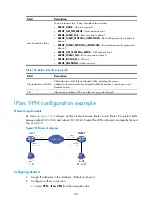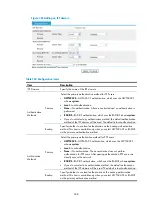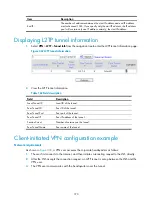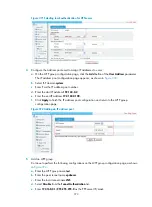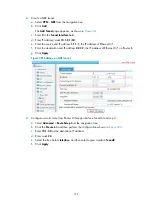
365
3.
Configure the L2TP group information, as described in
.
4.
Click
Apply
.
Table 159
Configuration items
Item Description
L2TP Group Name
Specify the name of the L2TP group.
Peer Tunnel Name
Specify the peer name of the tunnel.
Local Tunnel Name
Specify the local name of the tunnel.
Tunnel Authentication
Enable or disable L2TP tunnel authentication in the group. If you
enable tunnel authentication, you need to set the authentication
password.
Either the LAC or LNS end can initiate a tunnel authentication
request. If tunnel authentication is enabled on one end, the tunnel
can be established successfully only if the other end is also
enabled with tunnel authentication, and the two ends are
configured with the same authentication passwords. If tunnel
authentication is disabled on both ends, authentication passwords
do not take effect.
IMPORTANT:
•
Typically, you must enable tunnel authentication on both ends
of the tunnel for security. You can disable tunnel authentication
if you want to test the network connectivity or let the local end
receive connections initiated by unknown peers.
•
To change the tunnel authentication password, do so after
tearing down the tunnel. Otherwise, your change does not take
effect.
Authentication Password
PPP
Authentication
Configuration
Authentication
Method
Select the authentication method for PPP users on the local end.
You can select PAP or CHAP. If you do not select an authentication
method, no authentication will be performed.
ISP Domain
Specify the ISP domain for PPP user authentication. You can:
•
Click
Add
to enter the page for adding an ISP domain, as
shown in
. For information about the configuration
items, see
.
•
Select an ISP domain and click
Modify
to enter the ISP domain
modification page. For information about the configuration
items, see
.
•
Select an ISP domain and click
Delete
to delete the ISP domain.
If you specify an ISP domain, the specified domain is used for
authentication, and IP addresses must be assigned from the
address pool configured in the specified domain.
If you do not specify any ISP domain, the system checks whether
the domain information is carried in a username. If yes, the
domain is used for authentication; otherwise, the default domain
(system by default) is used for authentication.
PPP Address
PPP Server IP/Mask
Specify the IP address and mask of the local end.
Summary of Contents for MSR SERIES
Page 17: ...xv Documents 835 Websites 835 Conventions 836 Index 838 ...
Page 20: ...3 Figure 3 Initial page of the Web interface ...
Page 42: ...25 Figure 13 Firefox Web browser setting ...
Page 59: ...42 Figure 27 Checking the basic service configuration ...
Page 73: ...56 Figure 35 Sample interface statistics ...
Page 156: ...139 Figure 139 Rebooting the 3G modem ...
Page 168: ...151 Figure 152 Configuring Web server 2 ...
Page 174: ...157 Figure 158 Configure the URL filtering function ...
Page 242: ...225 Figure 233 Enabling the DHCP client on interface Ethernet 0 1 ...
Page 247: ...230 Figure 236 The page for configuring an advanced IPv4 ACL ...
Page 255: ...238 Figure 241 Advanced limit setting ...
Page 298: ...281 e Click Apply 2 Configure Router B in the same way Router A is configured ...
Page 400: ...383 Figure 387 Verifying the configuration ...
Page 405: ...388 ...
Page 523: ...506 Figure 530 Ping configuration page ...
Page 775: ...758 Figure 785 Configuring a jump node ...









